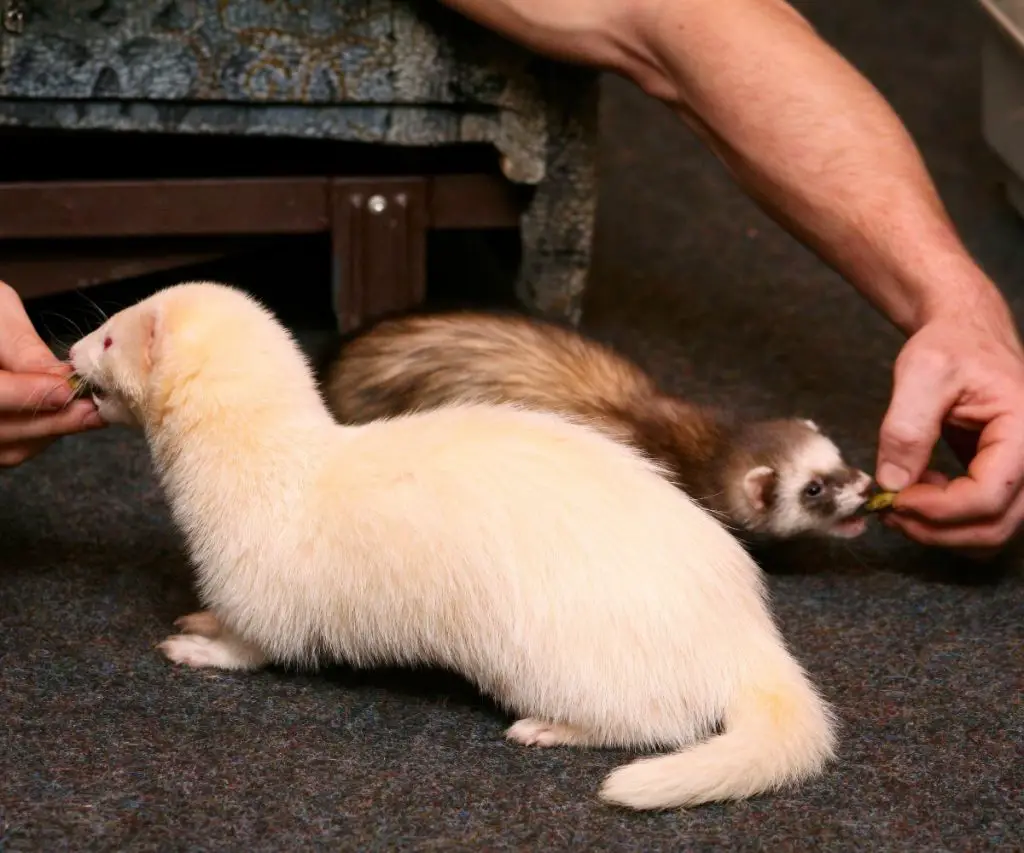Ferrets can be quite a bit weasley, so is it possible to train them to come when called?
Some animals in the weasel (Mustelid) family, like minks, remain wild and undomesticated even after 70 generations of captivity. However, ferrets (Mustela putorius furo) have been domesticated and trainable animals for at least 2000 years.
During the time that ferrets have been domesticated, they’ve adapted to learn commands from humans. While they are not likely to learn more complicated tricks like a dog, they can learn to follow simple commands.
Do ferrets come when called? One of the commands a ferret is capable of learning is to come when called. Read on to learn more about teaching ferrets to come when called, along with training steps and tips.
Do Ferrets Come When Called?
Ferrets aren’t as consistently obedient as dogs. However, it is possible to train a ferret to come when called. All that’s needed are treats, time, and patience.

Can Ferrets Be Trained to Come When Called?
Ferrets are distractible and hyperactive. However, ferret owners can quickly train their ferrets to come when called.
Treats can help enforce good behaviors in ferrets. So, it’s important to use treats during training. Without a treat, the ferret will lack the motivation to come when called.
Is It Easy to Train Your Ferret to Come When Called?
Ferrets are very trainable. Although, some ferrets are easier to train than others. Luckily, unlike dogs, there is only one breed of domesticated ferret, so there are no breed-specific training tips to consider.
Ferrets have some personality challenges to overcome for training purposes:
- They prefer to please themselves: Unlike dogs, ferrets aren’t concerned about pleasing their owner.
- They have a short attention span: Thus, training sessions should be short.
- They need time to play: When ferrets first come out of their cage, they are overly excited to play and won’t be interested in training. A ferret must slow their play before any training session.

What Age Should You Start Training Ferrets?
Ferrets start to gain more impulse control at around age seven months, so it’s best to start training after they’re seven months old or older. Other than that, there’s not a certain age at which it’s best to train ferrets.
How Much Does It Cost to Train a Ferret?
In rare cases, it may be possible to find a local pet training class available for ferrets. However, in most cases, it’s going to be the owner who trains their ferret.
The only cost involved in an owner training their ferret is the cost of treats and, possibly, a clicker.
What Is a Good Training Treat for Ferrets?
The best training treats for ferrets are the ferret’s favorite food. Since ferrets imprint on their favorite foods during their first year of life, a treat with a new flavor may not be as effective as something familiar.
Make sure that the ferret treats are cut small enough to use generously during the entire training session.
It’s also valuable to note that ferrets only eat to fulfill their caloric needs. A ferret may wander away from a training session when they are no longer hungry.

Benefits of Training a Ferret to Come When Called
Training a ferret to come when called allows an owner to create a desirable behavior to overcome distractions.
A ferret that comes when called is easier to put into their cage and easier to call away from a situation that could be hazardous to their health. This training is also helpful to coax a ferret out of small places.
Training Resources
Some individuals and organizations like the International Association of Animal Behavior Consultants have developed courses for ferret owners to understand ferret training on a deeper level.
How To Train A Ferret To Come?
To train a ferret to come to you, you need to isolate the ferret, beckon it with a treat and commands, beckon from further away, and repeat.
Training sessions with each ferret should last only about 10-15 minutes so that the ferret doesn’t lose interest.
1. Isolate the Ferret
Training should begin in a neutral location with no negative associations.
The training location should also be free of other ferrets. Training multiple ferrets together is an exercise in futility because they will be too busy playing together and distracting each other.
After the training session with the first ferret has ended, training with the next one can begin.
2. Beckon the Ferret with a Treat and Commands
During the first training phase, the trainer should hold the treat about one foot from the ferret.
As soon as the ferret approaches the food, the trainer should use the command they want the ferret to associate with coming when called.
Command Variations
- Call out a command word like “come” (especially helpful when calling multiple ferrets.
- Call out the animal’s name as a command word.
- Combine the command word with a summoning hand motion.
- Use a clicker.
- Combine the clicker with a command word.

Do Ferrets Know Their Names?
Ferrets are extremely intelligent animals. According to the American Ferret Association, ferrets recognize their names.
Ferret owners with multiple ferrets can use a general command word to get all their ferrets to come when called. However, using the ferret’s name during training can help a ferret owner single out which ferret comes when called.
3. Beckon the Ferret from Farther and Farther Away
As the ferret training progresses, it’s necessary to beckon it to come when called from increasingly farther away. Like before, the trainer should beckon the ferret with a treat and commands.
The training should progress to two feet away, three feet away, four feet away, and farther.
Beckoning from Out of Sight
After the ferret starts regularly coming when called from longer distances, it will be possible to try calling the ferret from another room.
Variations for the Over-Eager Ferret
Sometimes, a ferret will start to anticipate the treat and come forward before the trainer calls.
Option #1 for the over-eager ferret:
- Hide the treat when the ferret moves forward.
- Use the training command.
- Show the ferret the treat.
Option #2 for the over-eager ferret:
- Use the training command when the ferret moves forward.
- Reward the ferret with the treat.
Both options help the ferret associate the training command for coming when called with a reward.
4. Repeat
Repetition is key to the ferret starting to associate the commands for coming when called with rewards. The trainer should repeat the whole process at least 5-10 times in a row.
Eventually, the ferret will begin to come when called from anywhere in the home.
Final Tips for Training Ferrets to Come When Called
Do ferrets come when called? It’s easy to train them to come on command. However, it’s important to remember a few tips to make training sessions the most successful:
- Timing: The best time to train a ferret is when it’s happy, energetic, and has already had time to play. Otherwise, its focus will not be on the training, and it won’t come when called.
- Encouragement: Ferrets love praise and may not continue to come when called without encouragement. Motivation can be in the form of a pat on the head or a treat.
- Short lessons: Ferrets are easily bored, so 10-minute training sessions are best. Anything more than 30 minutes would be excessive.
- Rest: Ferrets need rest between training sessions.
- Treats: Ferrets will expect treats for coming when called long after the initial training phase.
Following these suggestions and the training methods outlined above can have a ferret coming when called in no time.

